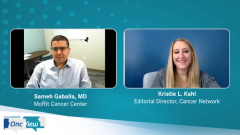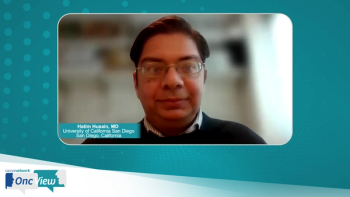
Treatment Options in Relapsed/Refractory Follicular Lymphoma
Sameh Gaballa, MD, discusses patients who relapse after frontline treatment as well as prognostic and predictive factors for relapse.
Episodes in this series

Kristie L. Kahl: Welcome to Cancer Network®’s OncLive® program titled “Management of Relapsed/Refractory Follicular Lymphoma.” Our discussion is going to focus on the treatment options for relapsed/refractory follicular lymphoma and the future treatment options. Welcome, and let’s begin. Dr Gaballa, first we’re going to talk about treatment options. How many patients relapse after frontline therapy?
Sameh Gaballa, MD: Patients with follicular lymphoma are not expected to be cured, and some patients will have very long remission durations. The thought is that, ultimately, everybody should relapse. We all have some patients who have been in remission for 10 to 15 years, and the question is: Will they relapse? Ultimately, most of these patients would relapse at some point.
Kristie L. Kahl: How does relapse impact prognosis?
Sameh Gaballa, MD: There is a subset of patients we would call the POD24s. These are patients who would be relapsing within 2 years of chemo-immunotherapy. These patients have worse overall survival compared with the rest of patients. The other 80% of patients, who remain in remission for 2 years or more after chemo-immunotherapy, have very good prognosis. There have been some retrospective studies that shows the survival of many of these patients is similar to the general population. It’s the high-risk group of patients that relapse early. These are the troublemakers.
Kristie L. Kahl: When it comes to relapse/refractory follicular lymphoma, what are the treatment goals?
Sameh Gaballa, MD: You’re fighting to control symptoms. The disease is not expected to be cured, so that’s why we do not treat everybody. If they’re asymptomatic, they have low bulky disease. We have some criteria like the French GELF [Groupe d’Etude des Lymphomes Folliculaires] criteria or the British criteria to try to define which patients are symptomatic. The bottom line is that if they have bulky disease, if they have symptomatic disease, then those are the patients you would consider treatment for. Otherwise, you could observe them because the goal is to control the symptoms. You’re not going to cure them. If it’s not causing any problems and you know your treatment is not going to cure it, then we typically do not treat those cases. The goal is to control symptoms.
Kristie L. Kahl: I know you mentioned a lot of patients end up relapsing, but what are the prognostic and predictive factors when it comes to relapse in follicular lymphoma?
Sameh Gaballa, MD: We do have some tools: we have the FLIPI [Follicular Lymphoma International Prognostic Index] score, the FLIPI2, and the M7 FLIPI that try to define high-risk vs low-risk patients. Personally, those don’t typically change management up front. If you have a high-risk patient who’s still asymptomatic, you’re still going watch. These aren’t really good predicting factors. But yes, patients with high FLIPI scores are more likely to relapse. What I think is most useful is POD24 [progression of follicular lymphoma within 24 months]. Obviously, you don’t know POD24 up front. You have to wait until after treatment.
Kristie L. Kahl: What are the treatment options for the first relapse in follicular lymphoma?
Sameh Gaballa, MD: Typically, in the first-line setting, if they have low bulky disease and they’re not— many will be symptomatic. If they are symptomatic sometimes, I would do a single agent; rituximab [Rituxan], for example. For most patients in the first-line setting, I would favor chemo-immunotherapy, rituximab and bendamustine [Treanda]. I reserve R-CHOP [rituximab, cyclophosphamide, hydroxydaunorubicin hydrochloride, vincristine, prednisone] typically for patients who possibly have transformed disease. Beyond the first line, there’s not 1 standard-of-care regimen. I think R2, lenalidomide and rituximab, is becoming more frequently used in the second line. R2 is very commonly used in the second line. Once you start getting into the third line, then you know and have a lot of options such as things like PI3-kinase inhibitors or EZH2 inhibitors. There is now approval for CAR [chimeric antigen receptor] T-cell therapy very recently in that space as well. There is approval for newer PI3-kinase inhibitors like umbralisib [Ukoniq]. Getting to the third line is really when you have a lot of options, but this is also the space where the patients are expected to stay in remission for a shorter time. Every line of therapy you go through, the progression-free survival will drop.
Transcript edited for clarity.
Newsletter
Stay up to date on recent advances in the multidisciplinary approach to cancer.






























































































